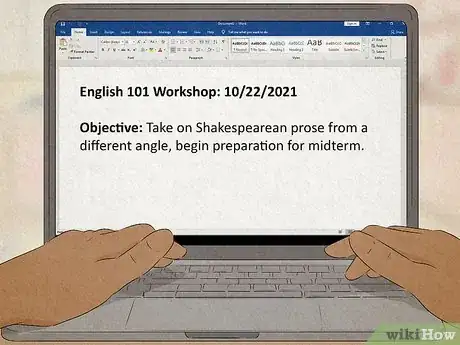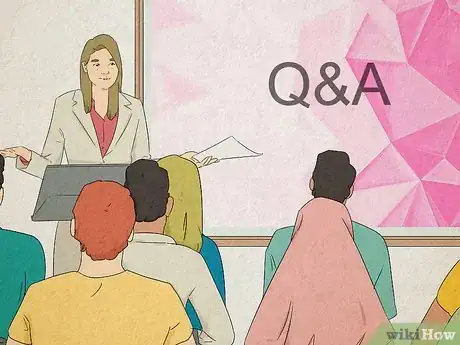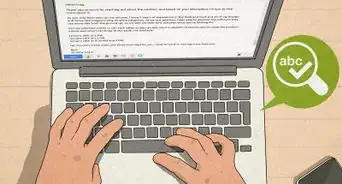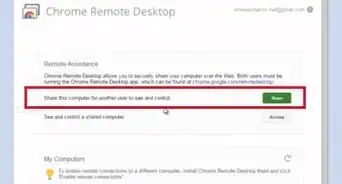This article was co-authored by Harish Chandran, PhD. Harish Chandran is the Engineering Site Lead and Senior Staff Research Engineer at DeepMind, where he leads the engineering efforts to integrate AI research results into Google products. Harish received his PhD in Computer Science from Duke University in 2012. While in graduate school, he worked as a Teaching Assistant, helping undergraduate students learn about algorithms and data structures. He has experience in DNA self-assembly, evolutionary algorithms, computational neuroscience, complexity theory, computer architecture, and super-computing.
wikiHow marks an article as reader-approved once it receives enough positive feedback. This article received 29 testimonials and 87% of readers who voted found it helpful, earning it our reader-approved status.
This article has been viewed 344,870 times.
A workshop is an informative or instructional class focused on teaching specialized skills or exploring a particular subject. Workshop presenters are usually educators, subject matter experts, managers or other leaders who possess knowledge of a particular subject or mastery of specific skills. Depending on the topic, workshops may be only one or two hours in length or extend across weeks of time. Workshop leaders can strengthen the effectiveness of their presentations through careful planning, organization, and presentation practice. Here are the steps for preparing a workshop.
Steps
Planning the Workshop
-
1Define the objective of the workshop. Your objective may be to teach a concrete skill, such as how to create and save documents in a word processing application. Or your aim may be to deliver general information or guidance about a specific topic, such as painting or creative writing. Regardless of the focus, it's important to define the objective first.[1]
-
2Determine the needs of workshop participants. When teaching a particular skill, for example, understanding the participants' needs concerning skill level and learning pace will assist you in delivering appropriate content. The more you tailor the workshop to your audience, the more effective the workshop will be.[2]Advertisement
-
3Create an outline for your workshop presentation.[3]
- Create an introduction. Decide how you will introduce yourself, the topic and the participant members.
- List the skills and/or topics you will cover. Create a comprehensive bulleted list. Include subtopics, as needed.
- Decide on the order of the topics. Move the most important skills or information to the early part of the workshop. Depending on the subject of the workshop, it may also be useful to introduce and build on each topic, beginning with the simplest or most straight forward topic and concluding with the more difficult or complex topic.
- Determine ground rules for the workshop. Rules or guidelines such as only one person speaks at a time or raising a hand to speak, as well as shutting off any cellphones or distracting devices are good to establish at the onset of the workshop.
- Decide how you will wrap up the workshop. You might include a short review of learned skills, announce the next level in a series of workshops and/or implement a participant feedback form.
-
4Assign an estimated length of time to each item on the outline. For particularly complicated topics or skills, allot a sufficient amount of time in case participants get stuck or have questions. It is also important to factor in scheduled breaks during the workshop to give the participants a chance to go to the bathroom or stretch their legs.
-
5Practice giving your workshop presentation once you complete your outline. Rehearsal is an important part of the workshop preparation process. Present your information to colleagues, friends or relatives ahead of time, and ask them to give you feedback on the clarity and effectiveness of your presentation.
Creating Supporting Materials
-
1Prepare handouts for participants. Convert your presentation outline into an agenda for participants and/or prepare hard copy handouts of important information or graphs.[4]
-
2Use visual tools. Presentation tools, movies, pictures, and other elements may be useful in conveying particular concepts or skills. Choose visual tools that complement your presentation and do not distract attention away from your core message or objective.
-
3Use web-based tools, if applicable. Open-source learning programs like Moodle and Blackboard, which are free to use, can help to facilitate online discussions and postings outside of the workshop setting. These web-based tools are also a great way for participants to submit homework or outside assignments online. More information on open-source learning programs can be found here: http://blog.capterra.com/top-8-freeopen-source-lmss/
Encouraging Workshop Participation
-
1Set up the room or space to encourage discussion. Arrange the chairs in a horseshoe shape or a semi-circle to facilitate conversation and post the ground rules on a board or wall where all participants can see them. Ensure a blank piece of paper on a board or wall, or a writing board, to brainstorm or document ideas and notes from the participants.[5]
-
2Incorporate interactive activities into your workshop. Activities or games can increase engagement and participation. Activities may occur in small or large groups.
-
3Include a question-and-answer portion. Depending on the ground rules of the workshop, invite participants to ask questions either throughout the workshop or in scheduled time slots.[6]
Community Q&A
-
QuestionWho are the participants?
 Community AnswerYour participants can be your friends, neighbors or anyone who is interested in your workshop.
Community AnswerYour participants can be your friends, neighbors or anyone who is interested in your workshop. -
QuestionHow do I get a license from the government when preparing a workshop?
 Esther Seib ShelleyCommunity AnswerWhy do you feel you need a license? You don't need a license to run a workshop. If you want to train on something, all you need to do is demonstrate your authority (why they should listen to you). That could be your doctorate training, or your business history, or something like that.
Esther Seib ShelleyCommunity AnswerWhy do you feel you need a license? You don't need a license to run a workshop. If you want to train on something, all you need to do is demonstrate your authority (why they should listen to you). That could be your doctorate training, or your business history, or something like that. -
QuestionHow do I, as the organizer of a music workshop, introduce the leader?
 Esther Seib ShelleyCommunity AnswerIf you are looking for a script overview, an good outline could be: 1. It's such an honor for me to present ....(leader name) to you! Two years ago (story) I had (this problem) and that caused (this issue) for me! (Leader name) stepped right in and did (etc) and that really helped me (mention the outcome of the solution you were given). And now, you get to hear him and enjoy and learn from him/her, too! Please join me in welcoming (leader name)! (Start to clap).
Esther Seib ShelleyCommunity AnswerIf you are looking for a script overview, an good outline could be: 1. It's such an honor for me to present ....(leader name) to you! Two years ago (story) I had (this problem) and that caused (this issue) for me! (Leader name) stepped right in and did (etc) and that really helped me (mention the outcome of the solution you were given). And now, you get to hear him and enjoy and learn from him/her, too! Please join me in welcoming (leader name)! (Start to clap).
References
- ↑ Harish Chandran, PhD. Machine Learning Engineer & PhD in Computer Science, Duke University. Expert Interview. 5 June 2019.
- ↑ https://cantina.co/five-tips-for-planning-workshops/
- ↑ http://nc.casaforchildren.org/files/public/site/conference/WorkshopOutline.pdf
- ↑ https://speakingaboutpresenting.com/delivery/presentation-handouts/
- ↑ https://ctlt.ubc.ca/2012/04/10/group-discussion-workshop-an-exercise-in-experiential-learning/
- ↑ http://www.ljlseminars.com/question.htm
About This Article
To prepare a workshop, start by figuring out what you want the participants to get out of it, whether it’s a concrete skill, or general information about a topic. Then, create an outline, deciding which topics you’ll cover, the order the topics will be presented, and how long each topic should take. After completing your outline, choose visual tools to enhance your presentation, like pictures, videos, and interactive worksheets. Finally, decide how you’ll wrap up the workshop, whether it’s a question and answer session, a participant feedback form, or a review of learned skills. To learn some web-based tools you can use to support your workshop, keep reading!









































































